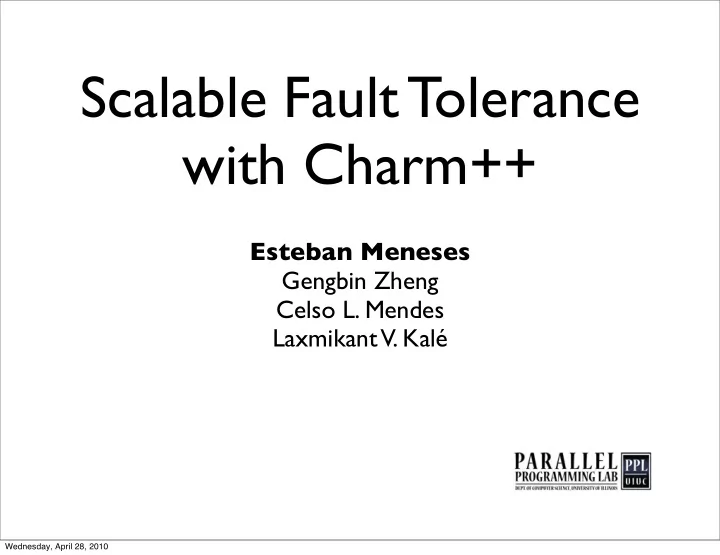

Scalable Fault Tolerance with Charm++ Esteban Meneses Gengbin Zheng Celso L. Mendes Laxmikant V. Kalé Wednesday, April 28, 2010
Contents • Fault Tolerance Techniques in Charm++ • Recent Developments • Future Work 2 Wednesday, April 28, 2010
A problem hard to ignore Installed System Processors SMTBF 2000 ASCI White 8,192 40.0 h 2001 PSC Lemieux 3,016 9.7 h 2002 NERSC Seaborg 6,656 351.0 h 2002 ASCI Q 8,192 6.5 h 2003 Google 15,000 1.2 h 2006 Blue Gene/L 131,072 147.8 h Extract taken from High-End Computing Resilience [1] 3 Wednesday, April 28, 2010
We will live with failures 2484 separate node crashes on Jaguar during 537 days period ( Aug-22-2008 to Feb-10-2010 ) 4.62 failures per day What about Sequoia with 1.6 million cores or an exascale machine with 100 million cores? 4 Wednesday, April 28, 2010
Overview of Charm++ Fault Tolerant Techniques Wednesday, April 28, 2010
Proactive Fault Tolerance • Use knowledge about impending faults. • Evacuate objects from processors that may fail soon. Charm++ Objects Processor B Processor A Processor C Sayantan Chakravorty, Celso L. Mendes, Laxmikant V. Kale, Proactive Fault Tolerance in MPI Applications via Task Migration , In Proceedings of HIPC 2006, LNCS volume 4297, page 485 6 Wednesday, April 28, 2010
Checkpoint/Restart • Double in-memory checkpoint. • Synchronized checkpoint. Charm++ Objects Memory Overhead Processor A Processor B Processor C Processor D (buddy of B) Gengbin Zheng, Lixia Shi, Laxmikant V. Kale, FTC-Charm++: An In-Memory Checkpoint-Based Fault Tolerant Runtime for Charm++ and MPI , Cluster 2004 7 Wednesday, April 28, 2010
Message Logging • Every message is stored in the sender log. • Pessimistic : messages and determinants have to be stored before delivery. m2 m Charm++ Objects m m2 Memory Overhead Processor A Processor B Processor C Processor D (buddy of B) Sayantan Chakravorty, Laxmikant V. Kale, A Fault Tolerance Protocol with Fast Fault Recovery , Proceedings of the 21st International Parallel and Distributed Processing Symposium, 2007, Long Beach California 8 Wednesday, April 28, 2010
Comparison (Reactive Approaches) Memory Communication Technique Recovery Time Overhead Overhead ☹ Checkpoint/ ☻ ☺ Restart ☹ ☹ Message ☺ Logging 9 Wednesday, April 28, 2010
Recent Developments Wednesday, April 28, 2010
Checkpoint/Restart Optimization • Discard old messages to resume progress as soon as possible. • Improve quiescence detection. • Combine message to update home location of objects. 11 Wednesday, April 28, 2010
Results Checkpoint Time Restart Time 0.22 22.5 0.165 16.9 Time (seconds) Time (seconds) 0.11 11.3 0.22 21.09 0.17 0.055 5.6 2.8 1.63 0 0 512 1024 512 1024 Number of cores Number of cores Application : Molecular3D (APOA1 ~100K atoms) Data Size : 624 KB per core (512 cores), 351 KB per core (1024 cores) 12 Wednesday, April 28, 2010
Message Logging Optimization • Memory overhead reduction: • Team-based approach. • Latency overhead reduction: • Causal protocol. 13 Wednesday, April 28, 2010
Team-based Approach • Goal: reduce memory overhead of message log. • Only messages crossing team boundaries are logged. m2 m Charm++ Objects m2 Memory Overhead Processor C Processor A Processor B (buddy of B) Team Y Team X 14 Wednesday, April 28, 2010
Processor Teams • Each team acts as a recovery unit : • All members must checkpoint in a coordinated fashion. • If one member fails, the whole team rolls back. Message Logging Checkpoint/Restart 1 k N Team Size Esteban Meneses, Celso L. Mendes and Laxmikant V. Kale, Team-based Message Logging: Preliminary Results , 3rd Workshop on Resiliency in High Performance Computing (Resilience) in Clusters, Clouds, and Grids (CCGRID 2010) 15 Wednesday, April 28, 2010
Results 16 Wednesday, April 28, 2010
Results (cont.) 17 Wednesday, April 28, 2010
Recovery Time 18 Wednesday, April 28, 2010
Further Developments • Highly connected objects should belong to the same team. • Exploit communication graph, dynamic groups, team-aware load balancer. • Teams can address some correlated failures. • Applicable to other message-logging protocols . Wednesday, April 28, 2010
Reducing Latency Object α Pessimistic m Message Object β m2 Logging Object γ Object α Causal m Message Object β m2 m3 ⊕ {m} Logging Object γ 20 Wednesday, April 28, 2010
Causal Protocol • No need to block the delivery of a message. • No need to contact remote processor for a local message. • Metadata is piggybacked in application’s messages. • Recovery may involve more processors. 21 Wednesday, April 28, 2010
Early Results Wednesday, April 28, 2010
Future Work Wednesday, April 28, 2010
Future Work Roadmap • Bigger Charm++ applications . • Enhance Proactive Approach with prediction schemes. • Enrich Team -based Approach. • Smarter team formation. • Coupling with load balancer. • SMP -aware fault tolerance. 24 Wednesday, April 28, 2010
Acknowledgments • Department of Energy – FastOS Program. • Colony-1 and Colony-2 projects. • NSF/NCSA • Deployment efforts specific for Blue Waters . • Machine allocation • TeraGrid MRAC – NCSA, TACC, ORNL • Greg Bronevetsky from LLNL. 25 Wednesday, April 28, 2010
References [1] Nathan DeBardeleben, James Laros, John Daly, Stephen Scott, Christian Engelmann and Bill Harrod. High End Computing Resilience: Analysis of Issues Facing the HEC Community and Path- Forward for Research and Development . Wednesday, April 28, 2010
Q&A 27 Wednesday, April 28, 2010
Thank You! Wednesday, April 28, 2010
Recommend
More recommend